Synergistic Integration of Multiple Wave Energy Converters with Adaptive Resonance and Offshore Floating Wind Turbines through Bayesian Optimization
Abstract
:1. Introduction
2. Synergistic Integration of Floating Offshore Wind Turbines with SR-WECs
2.1. Spatial Arrangement of SR-WECs in Collocated Array through Bayesian Optimization
2.2. Time-Domain Simulation Coupled with Aerodynamic, Mooring, and Power Take-Off Loads
3. Synergistic Integration of FOWT with SR-WEC
3.1. Optimal Spatial Arrangement Using Bayesian Optimization
3.2. Motion Response and Power Performance in Time-Domain Simulation
4. Conclusions
Author Contributions
Funding
Institutional Review Board Statement
Informed Consent Statement
Data Availability Statement
Acknowledgments
Conflicts of Interest
References
- Papi, F.; Bianchini, A. Technical challenges in floating offshore wind turbine upscaling: A critical analysis based on the NREL 5 MW and IEA 15 MW Reference Turbines. Renew. Sustain. Energy Rev. 2022, 162, 112489. [Google Scholar] [CrossRef]
- Jenne, D.S.; Yu, Y.-H.; Neary, V. Levelized Cost of Energy Analysis of Marine and Hydrokinetic Reference Models; National Renewable Energy Lab. (NREL): Golden, CO, USA, 2015.
- Pérez-Collazo, C.; Greaves, D.; Iglesias, G. A review of combined wave and offshore wind energy. Renew. Sustain. Energy Rev. 2015, 42, 141–153. [Google Scholar] [CrossRef]
- Fusco, F.; Nolan, G.; Ringwood, J.V. Variability reduction through optimal combination of wind/wave resources—An Irish case study. Energy 2010, 35, 314–325. [Google Scholar] [CrossRef]
- Babarit, A.; Ahmed, H.B.; Clément, A.H.; Debusschere, V.; Duclos, G.; Multon, B.; Robin, G. Simulation of electricity supply of an Atlantic island by offshore wind turbines and wave energy converters associated with a medium scale local energy storage. Renew. Energy 2006, 31, 153–160. [Google Scholar] [CrossRef]
- Astariz, S.; Iglesias, G. Enhancing wave energy competitiveness through co-located wind and wave energy farms. A review on the shadow effect. Energies 2015, 8, 7344–7366. [Google Scholar] [CrossRef]
- Astariz, S.; Perez-Collazo, C.; Abanades, J.; Iglesias, G. Towards the optimal design of a co-located wind-wave farm. Energy 2015, 84, 15–24. [Google Scholar] [CrossRef]
- Teixeira-Duarte, F.; Ramos, V.; Rosa-Santos, P.; Taveira-Pinto, F. Multi-objective decision tool for the assessment of co-located wave-wind offshore floating energy parks. Ocean. Eng. 2024, 292, 116449. [Google Scholar] [CrossRef]
- Jonasson, E.; Fjellstedt, C.; Temiz, I. Grid impact of co-located offshore renewable energy sources. Renew. Energy 2024, 230, 120784. [Google Scholar] [CrossRef]
- van der Zant, H.F.; Pillet, A.-C.; Schaap, A.; Stark, S.J.; de Weijer, T.A.; Cahyaningwidi, A.A.; Lehner, B.A. The energy park of the future: Modelling the combination of wave-, wind- and solar energy in offshore multi-source parks. Heliyon 2024, 10, e26788. [Google Scholar] [CrossRef]
- Clark, C.E.; Paredes, G.M. Effects of co-located floating wind-wave systems on fatigue damage of floating offshore wind turbine mooring cables. In Proceedings of the International Conference on Offshore Mechanics and Arctic Engineering, San Francisco, CA, USA, 4–7 November 2018; p. V001T001A024. [Google Scholar]
- Zhu, K.; Zheng, S.; Michele, S.; Cao, F.; Shi, H. Theoretical modeling of a co-located system with a floating wind platform and vertical truncated cylinders array. Renew. Energy 2024, 223, 120025. [Google Scholar] [CrossRef]
- Gubesch, E.; Sergiienko, N.Y.; Nader, J.-R.; Ding, B.; Cazzolato, B.; Penesis, I.; Li, Y. Experimental investigation of a co-located wind and wave energy system in regular waves. Renew. Energy 2023, 219, 119520. [Google Scholar] [CrossRef]
- Clark, C.E.; Velarde, J.; Sønderkær Nielsen, J. Fatigue load reductions in offshore wind turbine monopile foundations in co-located wind-wave arrays. In Proceedings of the International Conference on Offshore Mechanics and Arctic Engineering, San Francisco, CA, USA, 4–7 November 2018; p. V001T001A037. [Google Scholar]
- Jin, C.; Meduri, A.; Kang, H. Multivariable design optimization for adaptive resonance of a surface riding wave energy converter. Ocean Eng. 2023, 286, 115576. [Google Scholar] [CrossRef]
- Allen, C.; Viscelli, A.; Dagher, H.; Goupee, A.; Gaertner, E.; Abbas, N.; Hall, M.; Barter, G. Definition of the UMaine VolturnUS-S Reference Platform Developed for the IEA Wind 15-Megawatt Offshore Reference Wind Turbine; National Renewable Energy Lab. (NREL): Golden, CO, USA, 2020.
- Lee, C. Theory Manual; Massachusettes Institute of Tech: Cambridge, MA, USA, 1995. [Google Scholar]
- Ogden, D.; Ruehl, K.; Yu, Y.-H.; Keester, A.; Forbush, D.; Leon, J.; Tom, N. Review of WEC-Sim development and applications. Int. Mar. Energy J. 2022, 5. [Google Scholar] [CrossRef]
- Sirigu, M.; Faraggiana, E.; Ghigo, A.; Bracco, G. Development of MOST, a fast simulation model for optimisation of floating offshore wind turbines in Simscape Multibody. Proc. J. Phys. Conf. Ser. 2022, 2257, 012003. [Google Scholar] [CrossRef]
- Blair, N.; DiOrio, N.; Freeman, J.; Gilman, P.; Janzou, S.; Neises, T.; Wagner, M. System Advisor Model (SAM) General Description (Version 2017.9.5); NREL/TP-6A20-70414; National Renewable Energy Laboratory (NREL): Golden, CO, USA, 2018.
- Gaertner, E.; Rinker, J.; Sethuraman, L.; Zahle, F.; Anderson, B.; Barter, G.; Abbas, N.; Meng, F.; Bortolotti, P.; Skrzypinski, W. Definition of the IEA 15-Megawatt Offshore Reference Wind Turbine; National Renewable Energy Laboratory (NREL): Golden, CO, USA, 2020.
- Neary, V.S. Characterization of US Wave Energy Converter (WEC) Test Sites: A Catalogue of Met-Ocean Data; EERE Publication and Product Library: Washington, DC, USA, 2015. [Google Scholar]
- Garnett, R. Bayesian Optimization; Cambridge University Press: Cambridge, UK, 2023. [Google Scholar]
- Ledoux, J.; Riffo, S.; Salomon, J. Analysis of the blade element momentum theory. SIAM J. Appl. Math. 2021, 81, 2596–2621. [Google Scholar] [CrossRef]
- Wendt, F.F.; Andersen, M.T.; Robertson, A.N.; Jonkman, J.M. Verification and validation of the new dynamic mooring modules available in FAST v8. In Proceedings of the ISOPE International Ocean and Polar Engineering Conference, Rhodes, Greece, 26 June–1 July 2016; p. ISOPE-I-16-315. [Google Scholar]
- Wood, G.D.; Kennedy, D.C. Simulating mechanical systems in Simulink with SimMechanics. Mathworks Rep. 2003, 210. [Google Scholar]
- Sheshaprasad, S.; Naghavi, F.; Hasanpour, S.; Albader, M.; Gardner, M.C.; Kang, H.; Toliyat, H.A. Optimal Electric Power Take-off Strategy for Surface Riding Wave Energy Converter. In Proceedings of the 2022 IEEE Energy Conversion Congress and Exposition (ECCE), Detroit, MI, USA, 9–13 October 2022; pp. 1–7. [Google Scholar]
- Stehly, T.; Duffy, P. 2020 Cost of Wind Energy Review; National Renewable Energy Lab. (NREL): Golden, CO, USA, 2021.
- Yu, Y.-H.; Jenne, D.; Thresher, R.; Copping, A.; Geerlofs, S.; Hanna, L. Reference Model 5 (rm5): Oscillating Surge Wave Energy Converter; National Renewable Energy Lab. (NREL): Golden, CO, USA, 2015.
- Short, W.; Packey, D.J.; Holt, T. A Manual for the Economic Evaluation of Energy Efficiency and Renewable Energy Technologies; National Renewable Energy Lab. (NREL): Golden, CO, USA, 1995.
- Ancellin, M.; Dias, F. Capytaine: A Python-based linear potential flow solver. J. Open Source Softw. 2019, 4, 1341. [Google Scholar] [CrossRef]
- Babarit, A.; Delhommeau, G. Theoretical and numerical aspects of the open source BEM solver NEMOH. In Proceedings of the 11th European Wave and Tidal Energy Conference (EWTEC2015), Nantes, France, 6–11 September 2015. [Google Scholar]
- Carter, D. Prediction of wave height and period for a constant wind velocity using the JONSWAP results. Ocean Eng. 1982, 9, 17–33. [Google Scholar] [CrossRef]
- Bañuelos-Ruedas, F.; Angeles-Camacho, C.; Rios-Marcuello, S. Analysis and validation of the methodology used in the extrapolation of wind speed data at different heights. Renew. Sustain. Energy Rev. 2010, 14, 2383–2391. [Google Scholar] [CrossRef]
- Clark, C.E.; Miller, A.; DuPont, B. An analytical cost model for co-located floating wind-wave energy arrays. Renew. Energy 2019, 132, 885–897. [Google Scholar] [CrossRef]
- Astariz, S.; Perez-Collazo, C.; Abanades, J.; Iglesias, G. Co-located wave-wind farms: Economic assessment as a function of layout. Renew. Energy 2015, 83, 837–849. [Google Scholar] [CrossRef]
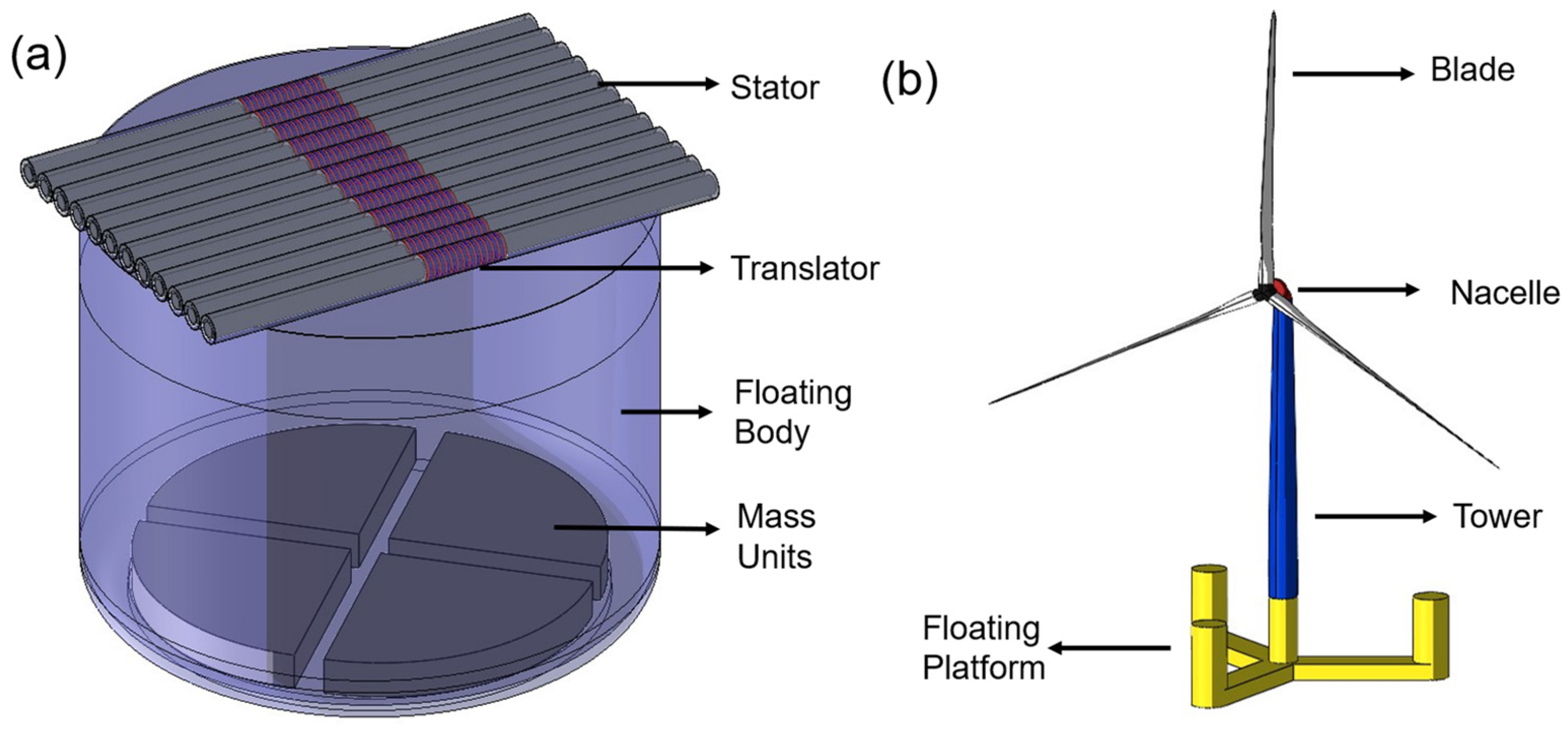
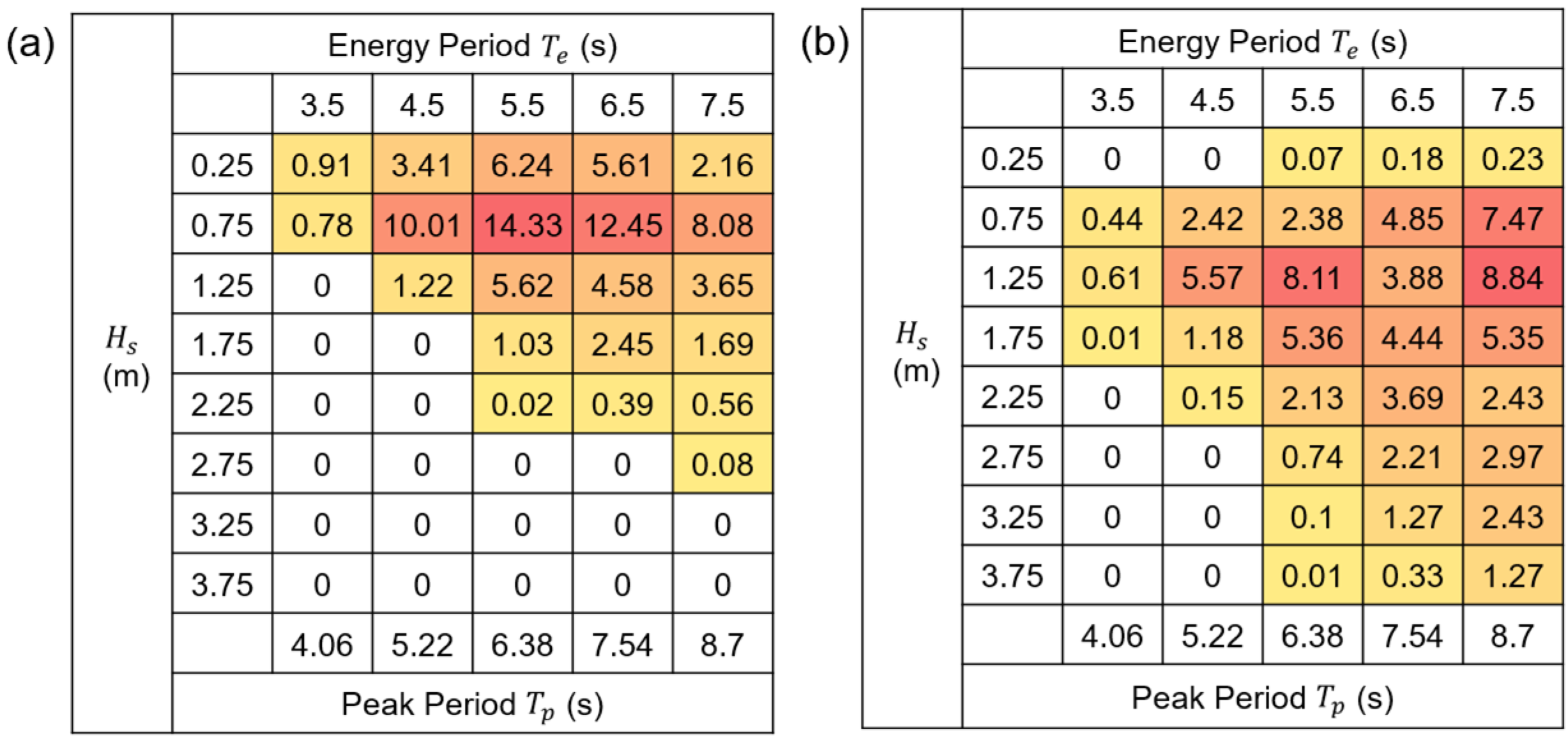

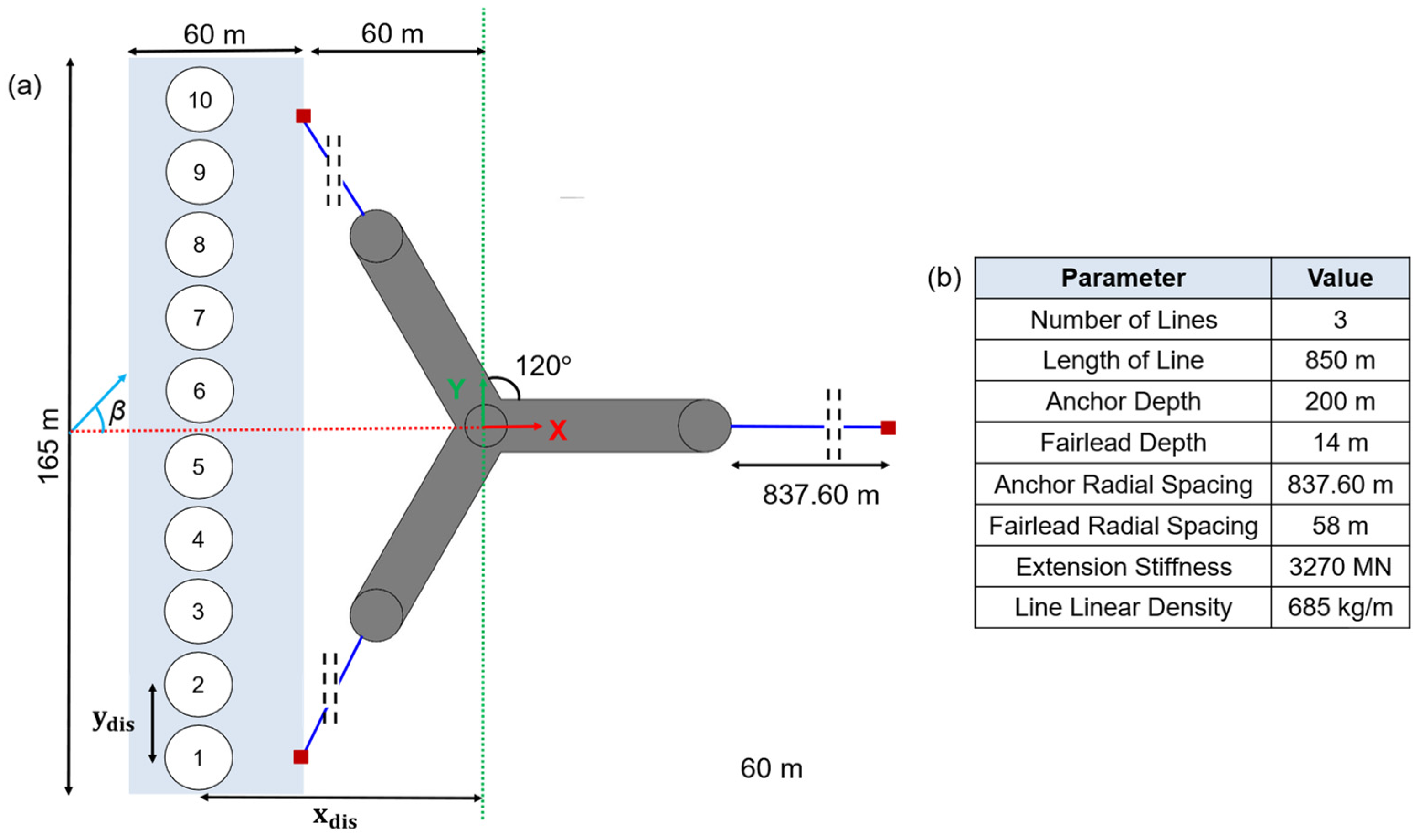



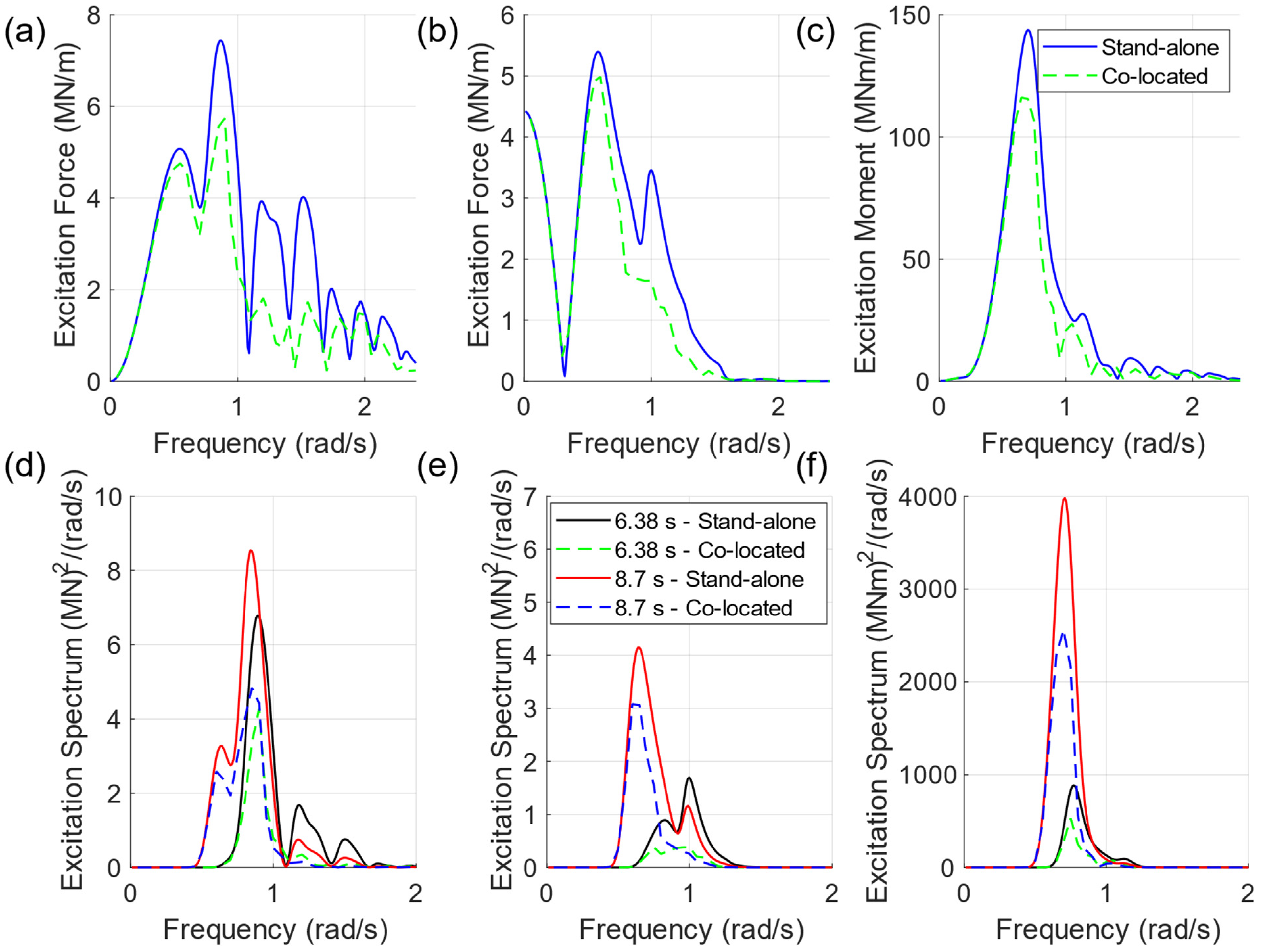
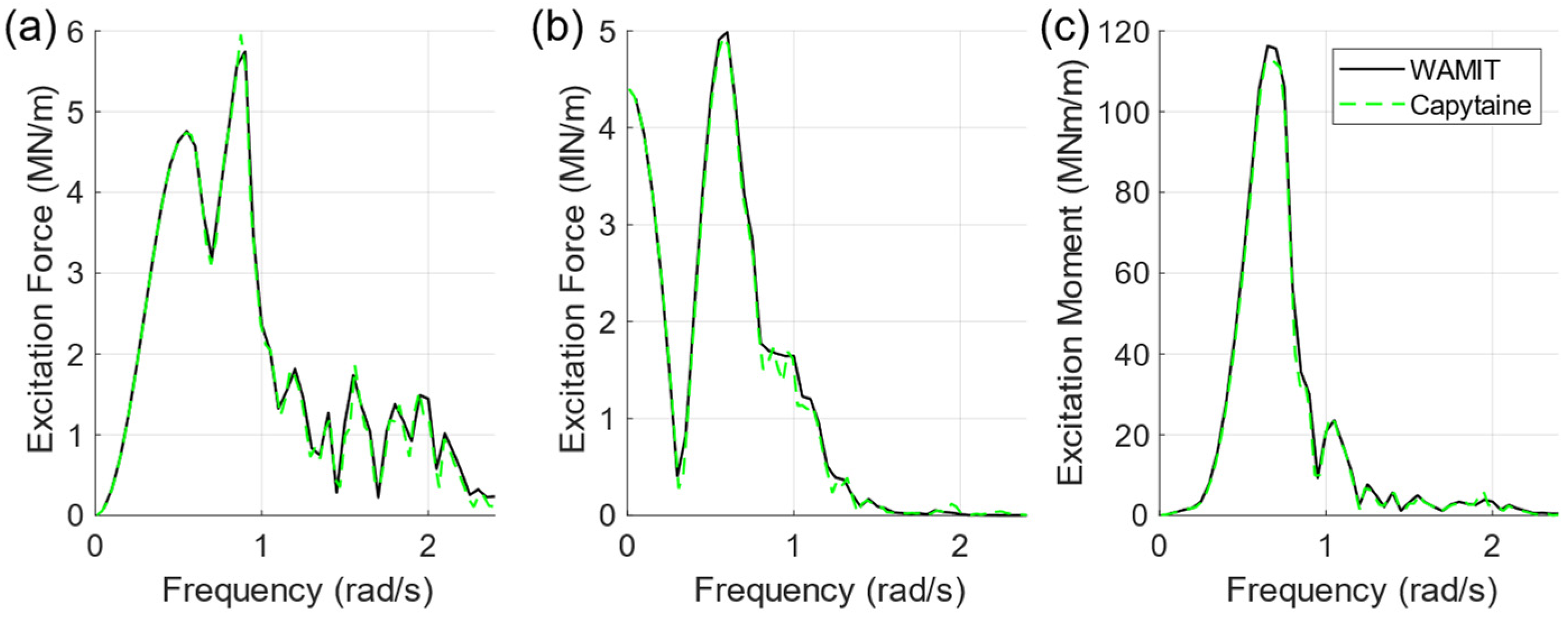

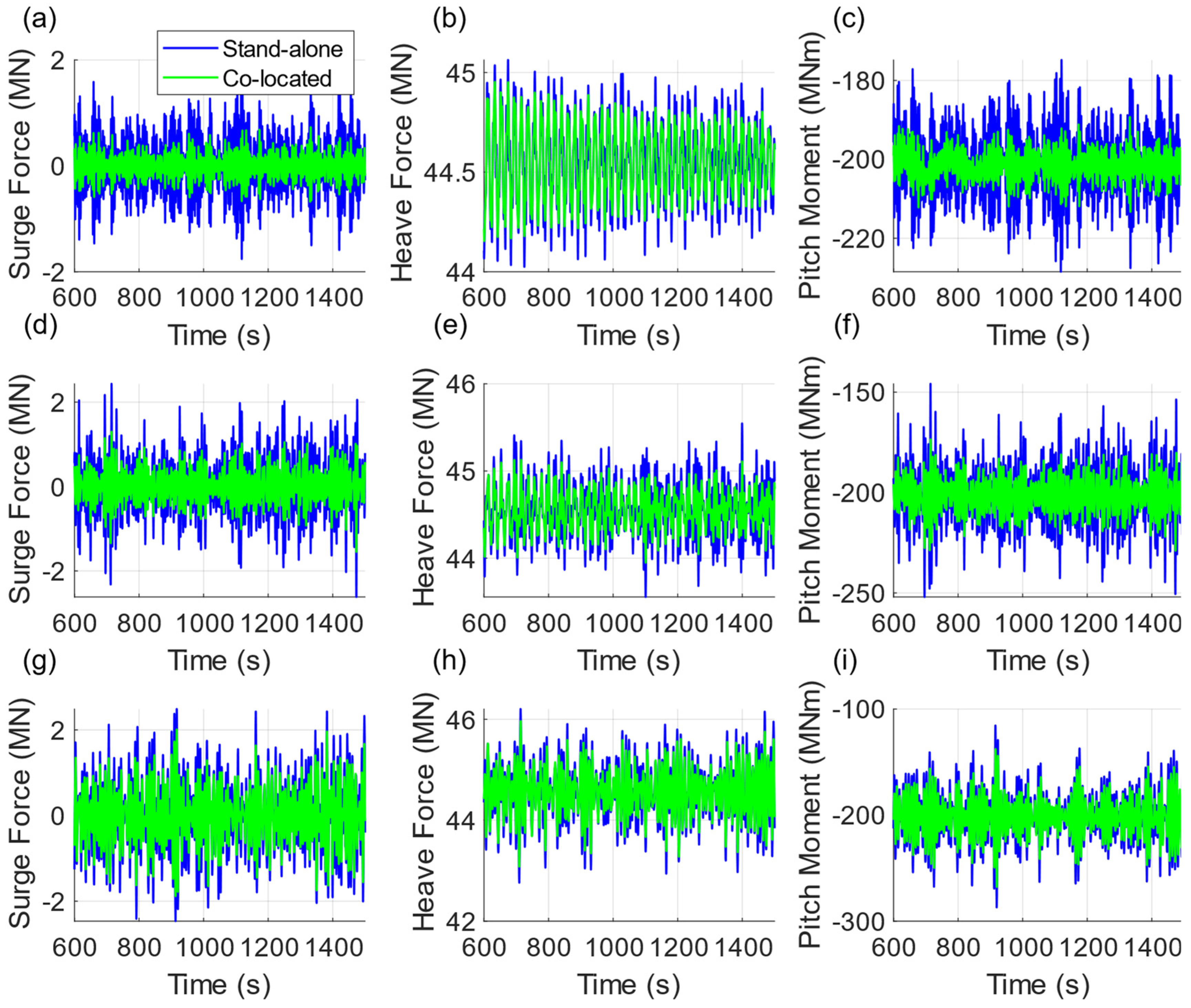
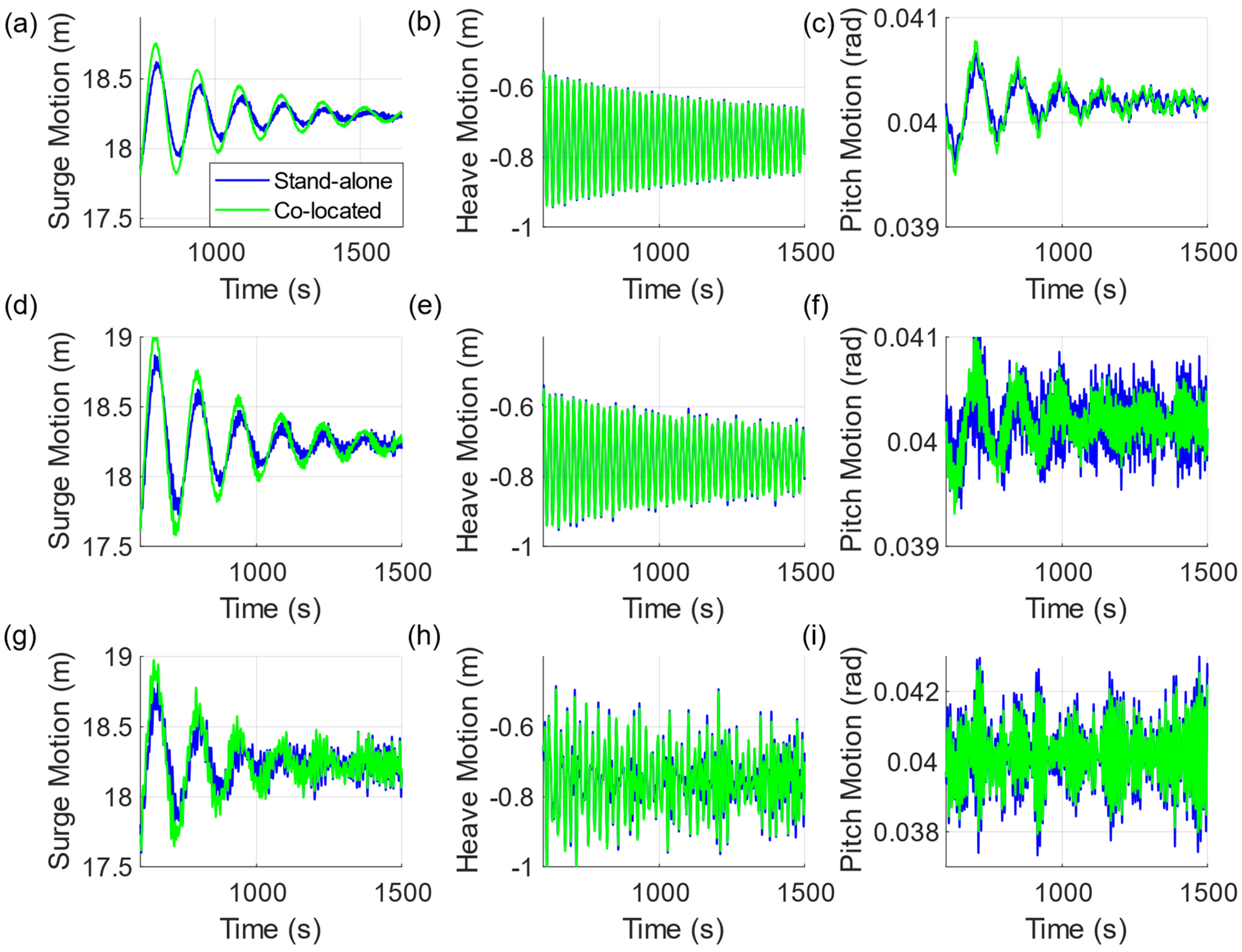
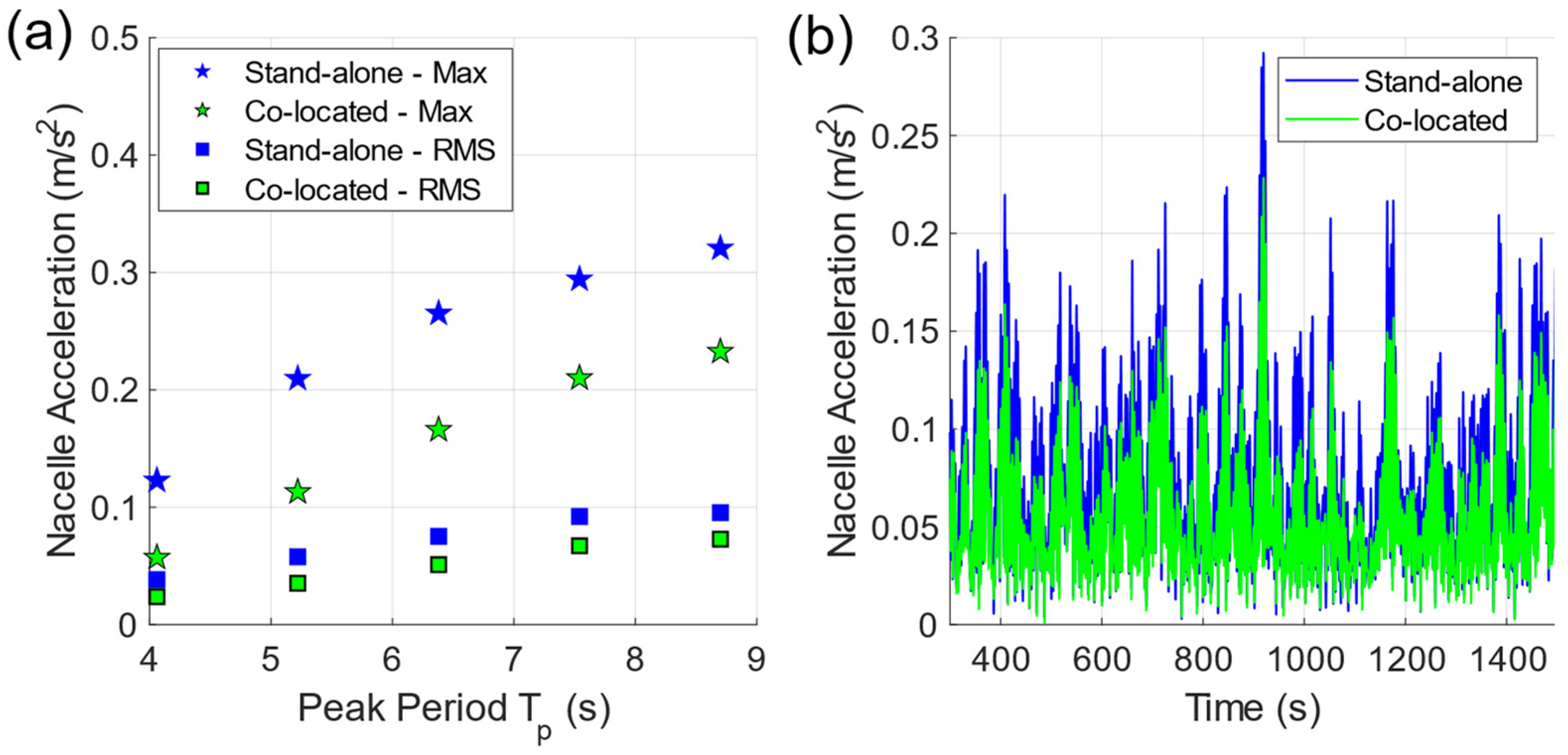
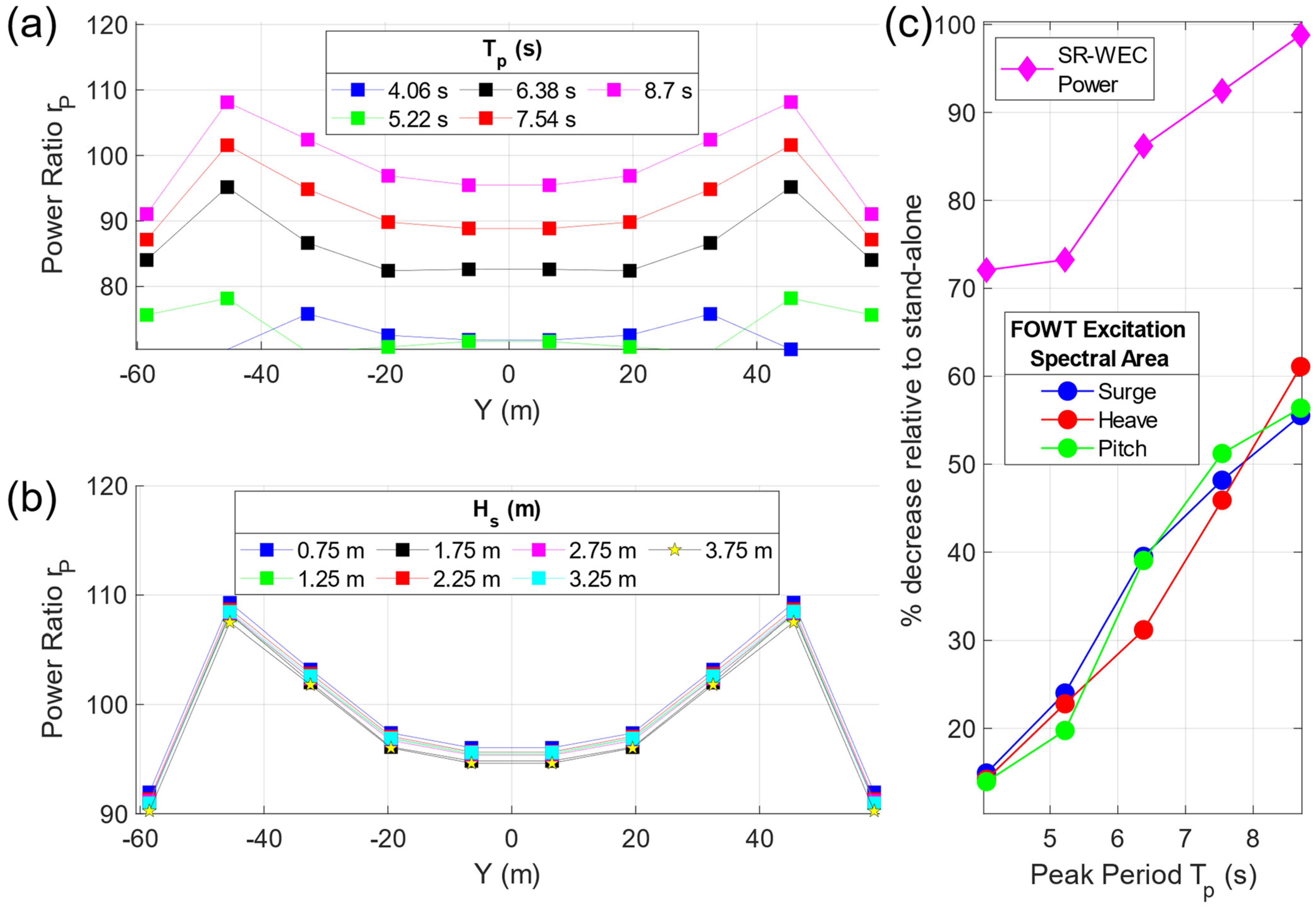
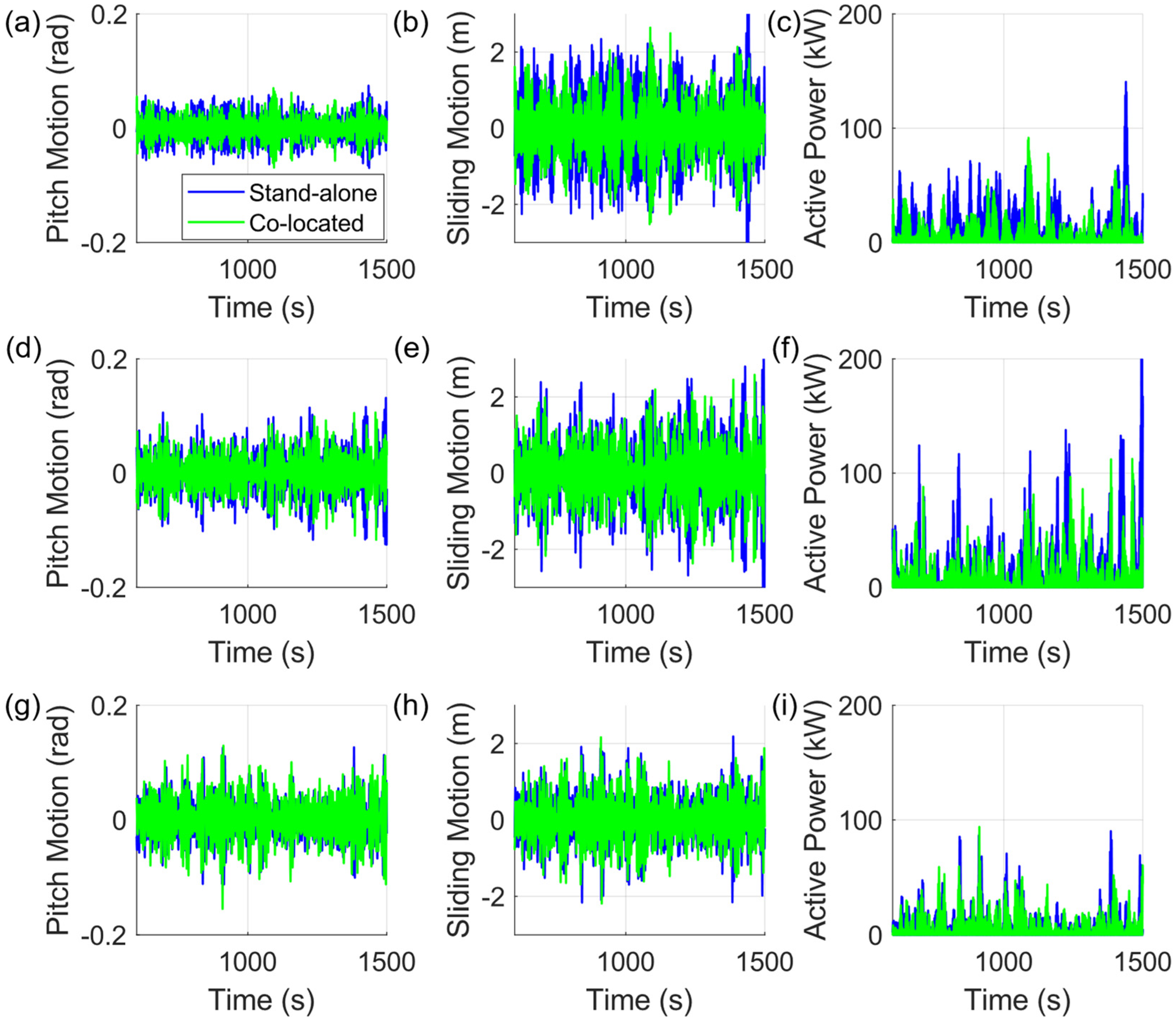

| Index | Parameter | Stand-Alone SR-WEC Array | Stand-Alone FOWT | Co-Located SR-WEC-FOWT |
|---|---|---|---|---|
| C1 | Device Cost ($) | $14,713,630 | $19,515,000 | $34,228,630 |
| C2 | Balance of System Cost ($) | $750,000 | $48,510,000 | $48,913,320 |
| C3 | Financial Cost($) | $154,236 | $12,240,000 | $12,394,236 |
| C4 | Total Capital Cost ($) (C1 + C2 + C3) | $15,617,866 | $80,265,000 | $95,536,186 |
| C5 | Annual OpEx (FOC) ($) | $42,680 | $1,770,000 | $1,557,600 |
| C6 | Fixed Charge Rate (%) | 10.80% | 5.82% | 5.82% |
| C7 | AEP (kWh) | 1,443,128 | 56,362,308 | 57,805,438 |
| C8 | LCOE ($/kWh) ((C6 C4 + C5)/C7) | $1.198 | $0.114 | $0.123 |
Disclaimer/Publisher’s Note: The statements, opinions and data contained in all publications are solely those of the individual author(s) and contributor(s) and not of MDPI and/or the editor(s). MDPI and/or the editor(s) disclaim responsibility for any injury to people or property resulting from any ideas, methods, instructions or products referred to in the content. |
© 2024 by the authors. Licensee MDPI, Basel, Switzerland. This article is an open access article distributed under the terms and conditions of the Creative Commons Attribution (CC BY) license (https://creativecommons.org/licenses/by/4.0/).
Share and Cite
Meduri, A.; Kang, H. Synergistic Integration of Multiple Wave Energy Converters with Adaptive Resonance and Offshore Floating Wind Turbines through Bayesian Optimization. J. Mar. Sci. Eng. 2024, 12, 1455. https://doi.org/10.3390/jmse12081455
Meduri A, Kang H. Synergistic Integration of Multiple Wave Energy Converters with Adaptive Resonance and Offshore Floating Wind Turbines through Bayesian Optimization. Journal of Marine Science and Engineering. 2024; 12(8):1455. https://doi.org/10.3390/jmse12081455
Chicago/Turabian StyleMeduri, Aghamarshana, and HeonYong Kang. 2024. "Synergistic Integration of Multiple Wave Energy Converters with Adaptive Resonance and Offshore Floating Wind Turbines through Bayesian Optimization" Journal of Marine Science and Engineering 12, no. 8: 1455. https://doi.org/10.3390/jmse12081455






